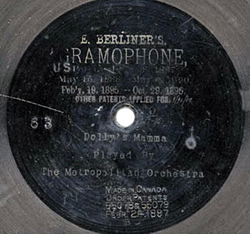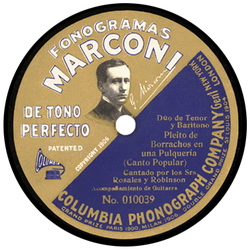|
Consuming Passions: The Record As An Art Object
by John Black
Berliner disc

|
|
Last century,
when
inventors
and entrepreneurs
strived to perfect recorded sound, the
aim
was primarily status and cash. The indifferent
performances they recorded
meant
only
cheap
entertainment
and
profitable
business.
A
few Individuals like Fred Gaisberg
foresaw the process as
a unique historical
document.
But
no one predicted the phenomenon of the collector - especially those who
want only to possess
and
admire a record just for
qualities other than
content.
In the early years
disc recordings
were manufactured
from some unusual
substances as well
as a variety of sizes, speeds and colors.
Emile Berliner's
first discs issued circa 1890 were 5" In diameter,
(as are today's
compact discs)
and
made of
a
hard rubber or cellulose-like
material.
They were laterally cut
as opposed to Edison's vertically-cut
cylinders. Meant to be played on a hand-wound
toy Gram-O-Phone
the playback speed
was as
uncertain
as
the
recording
speed.
But
a
nominal
78
rpm
can
be
assumed.
As with
all
discs
prior to
1908 they
were pressed
on one side only,
and were black
in color.
Marconi Velvet Face disc

|
|
Berliner's
7" discs appeared about
1894
and
the pirates
soon
followed.
The
extremely
rare American Vitaphone (circa 1898) reportedly
dubbed
from Berliner
masters
and red
in color.
During
complicated
legal
proceedings several
new
comers
issued
7" records.
They
included
Columbia,
Climax,
and the dark
blue
American
Odeon.
The pirate
Zon-O-Phone
(in
7" and 9" format)
and the embryonic
Victor company were also active. Later Canadian
Berliners
were
brown
in
color
and
had
a
brass centre hole.
The first 10" shellac discs were offered
by
Berliner
in
England
circa
1900.
This size
and substance
soon
became
standard
with
Gramophone and Typewriter
in Europe
and
the
American
Victor
and
Columbia.
To
this
point
most
discs
were cut
in
the
Berliner
lateral
method.
The exception
was
French
Pathe.
Starting
in
1906
they
issued
discs
based
on the vertical
method,
in sizes
from
8 1/2" to
a
massive 20" version
that weighed 6 lbs.
The
nominal
speed
was
90
rpm
but
the
20"
Concerts
were
to
be played at
120 to
130
rpm!
The first truly flexible (but
not
unbreakable record
was Introduced
by
Marconi
(of
wireless
fame)
in
1907.
Made
of
plastic,
the
"Velvet
Face"
surface soon succumbed to the heavy
pick-ups
of the day.
Columbia
initiated
double-faced records
in
1907
and Victor soon
followed.
The 10" size
was
used
for
popular
music
and the 12" for
classical.
But both firms experimented with
a
14" version for classical that proved unsuccessful.
These
are
now
extremely
rare. Visually
interesting
items
from this
period
were
issued
by
Columbia
licensees.
Standard
Discs had
a
1/2" spindle hole,
Harmony 's
was 3/4" and Arentino had an amazing
3"
chasm.
Edison diamond disc

|
|
Edison entered the
market
in
1913 with
a
1" thick,
vertically-cut,
laminated
"Diamond
Disc"
with
a
playing
speed
of
80
rpm. During the 'teens Victor,
Columbia and
Edison dominated the
North
American
scene,
but
many
new
(and often
short-lived)
hopefuls issued records of interest to collectors.
Small
records
were
not yet extinct.
Little
Wonder
presented
5 1/2"
single
face
gems
from circa
1911 to
1919.
The Emerson
Company,
formed. in
1919,
gave
us 5 1/2",
7",
9"
and
10" 78's.
The
lengendary
Bettini
also pressed
7" discs
In Italy.
From
1917
an abstract
five color vertical
cut
was
pressed by Aelolan-Vocalion
and a bizarre
triangular
record,
the
Pan,
came
from
England.
The
1920's
saw the rise
and fall
of
many
unusual
records.
(Victor
finally
dropped
its
one side only
Red Seal
in
1921.
They
considered
this
an
innovation.)
A
12"
variable speed disc was produced in
England
by
World
Records
in
1923.
requiring
a
special
gear
for
playback.
It
soon
disappeared. Other rarities
from the period
include
Blu-Disc,
made of a dark blue substance,
the
flexible
New
Flexo
(both
American)
and the microgroove
Marathon
and
unbreakable
Duophone from England.
Thomas
Edison, just
before
quitting the
record
business
in
the
middle
of
decade,
offered
both
a
long
play
33 1/3 rpm
Diamond
Disc
and
a
Berliner
electrically
recorded disc.
But it was too
little,
too
late for
TAE
and both the
LP
and the
"Needle
Cut"
are very rare today. The first 16" LP's were used by theatres to
accompany silent films.
Few survive today.
|